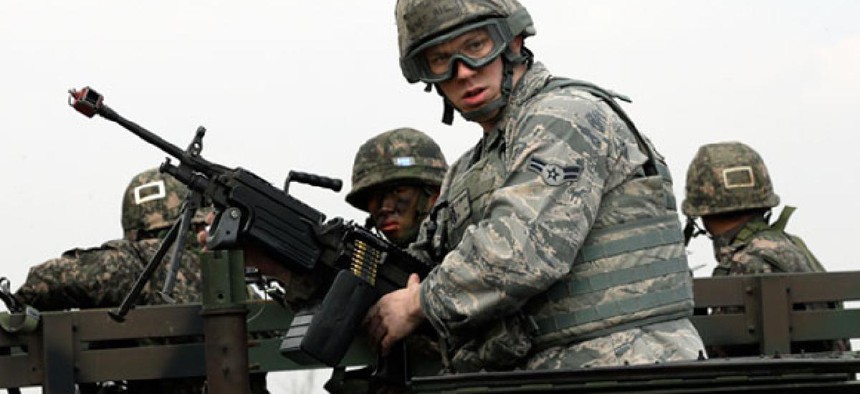
U.S. Air Force Airman First Class, Lee Simpson mans a machine gun atop a humvee, with South Korean soldiers during a joint military drill between South Korea and the United States near Seoul. Lee Jin-man/AP
Amid Deep Cuts, the Pentagon Labors to Keep Its Forces Ready for Korea
The military could react quickly in the event of hostilities, officials say.
As tensions escalate on the Korean Peninsula, the U.S. military is striving to maintain peak readiness for forces assigned to the region, Defense Department leaders said on Wednesday. Deep cutbacks in training and preparedness accounts taken this year because of the so-called budget sequester are making the job more difficult.
Pentagon Comptroller Robert Hale listed the ability to respond immediately with force in Korea, if necessary, among a short list of Defense priorities the Obama administration seeks to “protect” from the sequestration ax during the current budget year.
Overall, the department will absorb $41 billion in across-the-board cuts in fiscal 2013 under the congressionally mandated initiative, which took effect early this year when lawmakers were unable to agree on how to close the federal budget deficit.
The Pentagon would “limit effects” of cuts “to the extent feasible” in maintaining a U.S. capability to “fight tonight” in Korea, if a conflict were to erupt there, according to a budget slide Hale showed reporters during a briefing on defense spending plans for the upcoming fiscal year.
U.S. military personnel in key regions, including the Korean Peninsula, “are at full ready status,” meaning they could react quickly in the event of hostilities, said Air Force Lt. Gen. Mark Ramsay, the Joint Staff director for force structure, resources and assessment.
Hale was asked how that might change in light of this year’s sequester-driven cuts that the military services are saying will increasingly degrade the pace of training, exercises and preparedness over time.
“I sure don't want to leave the impression in the minds of any of our potential adversaries that this is an opportunity for them. It's not,” Hale said. “I mean, we're going to be there if we have to be.”
In addition, the 2011 Budget Control Act exempts “core” nuclear deterrence forces -- including the submarine, bomber and ICBM legs of the triad -- from sequester cuts, according to the comptroller’s briefing.
These exempted programs -- which also include Afghanistan operations, wounded warrior initiatives and essential travel for senior leaders -- would experience “little or no effects” from budget sequestration, the document states.
Over the past few weeks, North Korea has repeatedly threatened to attack the United States and South Korea in response to the U.N. Security Council’s condemnation of Pyongyang’s recent nuclear test.
Also meeting with reporters, Army Gen. Martin Dempsey, the chairman of the Joint Chiefs of Staff, would not say whether he believes North Korea has achieved the technical capacity to deliver a nuclear warhead on a ballistic missile.
Following the Feb. 12 nuclear test -- the North’s third underground explosive trial since October 2006 -- Washington and Seoul have been conducting annual military exercises in the region, much to Pyongyang’s dismay. North Korea has also staged its own defense drills and curtailed a key bilateral economic project with South Korea along their heavily fortified border.
U.S. and South Korean troops in the region on Wednesday went on high alert upon indications that North Korea was poised to launch an intermediate-range ballistic missile from its east coast.
Defense Secretary Chuck Hagel urged North Korean leader Kim Jong Un to tone down his nation’s confrontational statements and actions. At the same time, Hagel assured that U.S. forces remain ready to protect the nation and regional allies should violence occur.
With its “bellicose” rhetoric and activities, North Korea has “been skating very close to a dangerous line,” he said at the press conference. The temperature should be “ratcheted down,” he said, “in the interest of all countries.”
That said, if war breaks out, “our country is fully prepared to deal with any contingency, any action that North Korea may take or any provocation that they may instigate,” according to Hagel. “And we have contingencies prepared to do that.”
For fiscal 2014, the Obama administration is proposing a $615 billion Defense budget alternative that would avert a $52 billion cut that sequestration would otherwise impose during the coming fiscal year, Hagel said. The budget year begins on Oct. 1.
To avoid the 2011 budget law’s $500 billion in mandated cuts on military accounts over the next decade, the president’s new deficit-reduction plan calls for $150 billion in savings over 10 years. The biggest chunks are to be taken in later years, mostly after fiscal 2018.
The Pentagon’s pitch in the budget request is for lawmakers to enact into law this more modest blueprint as a replacement for sequestration’s deeper budget cuts. A number of Republicans on Capitol Hill are already rejecting the new bid and many analysts say Congress will likely opt to continue the sequester into the future.
Hagel said he anticipates that a Strategic Choices and Management Review, being led by Deputy Defense Secretary Ashton Carter, will by the end of May deliver specific recommendations for how best to apportion reductions in 2014 and beyond.
“We are living in a world of complete uncertainty,” the Defense secretary said. The proposed approach offers “the flexibility that we need to manage,” he said.
Representatives of the three military services indicated that even if sequestration is lifted, they would be struggling in 2014 to restore readiness after the training and operations cutbacks they must make this year to stay within sharp budget caps.
For example, the Air Force for the first time in its history is implementing a “tiered” approach to unit preparedness.
Roughly two-thirds of Air Force units will remain ready to undertake their assigned missions, said Maj. Gen. Edward Bolton, the service’s deputy assistant secretary for budget. However, about one-third of the service’s forces that are not deployed or preparing to deploy will be “standing down” and rated unready, he said.
The move will affect a number of nuclear-capable forces, with some B-2 bombers among Air Force aircraft that will be grounded for the remainder of the fiscal year, Defense News reported this week.
If the president succeeds in winning congressional approval for relief from the sequester cuts in the next fiscal year, normal training and operations schedules could resume.
Still, there are no additional funds for a “get-well plan” in the 2014 budget request that would make up for missed 2013 training, Bolton said. That means those forces that are unready as the new fiscal year begins will be playing catch-up to recover. He said it was unclear how long it would take to resume normal readiness.
Hale noted, though, that the strategic “pivot” toward Asia introduced during Obama’s first term in office would continue.
“Despite the budgetary problems, we are working to rebalance toward the Asia-Pacific region,” he said. “Our most capable forces [are being deployed] forward.
“We've sent F-22s [fighter jets] to Kadena [air base in] Okinawa,” Hale said. “By 2020, we'll have 60 percent of our Navy forces stationed in the Pacific region. We are working to expand access and cooperation, for example [with] a rotational presence in Australia [and] ships in Singapore.”
Dempsey concluded his and Hagel’s portion of the budget rollout with a note of disdain for the North Korean regime’s spending priorities, seeking to strike a contrast with the U.S. military.
“We're having a press conference today about the Defense Department absorbing hundreds of billions of dollars in reductions for the good of the American people so that the United States of America can get back on a more solid economic foundation,” the JCS chairman said. “And what is Kim Jong Un doing? He's starving his people with a military-first policy. It's pretty hard for us to figure that out.”
NEXT STORY: Obama Budget Pays for Military Base Closures







